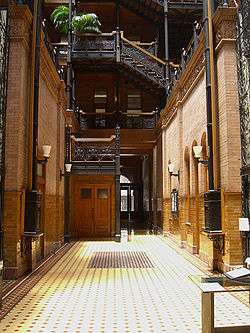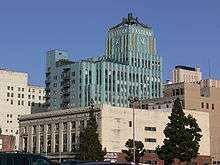Historic Core, Los Angeles
The Historic Core is an area in Downtown Los Angeles between Hill Street on the West, Los Angeles Street on the East, Third Street on the North, and Olympic Boulevard on the South.[1] It overlaps with the Jewelry District on its western end and Skid Row on its eastern end, and contains the Broadway Theater District and the Spring Street historic financial district.
Historic Core | |
|---|---|
Neighborhood of Los Angeles | |
 The iron-wrought interior of the Bradbury Building located on Broadway and 3rd St. | |
Historic Core Location within Downtown Los Angeles | |
| Coordinates: 34.05349°N 118.245319°W | |
| Country | |
| State | |
| County | Los Angeles County |
| City | |
| Named | 1990s |
| Zip code | 90013 |
| Streets | 3rd Street, 4th Street, Broadway, Hill Street, Main Street, Olympic Boulevard, Spring Street |

Architectural landmarks
The Historic Core is packed with a wealth of landmark buildings including the world's largest concentration of movie palaces as well as former large department stores, financial and other office towers, built chiefly between 1907 and 1931. See:
History
The Historic Core was the central business district (CBD) of the city from the first decade of the 1900s through the 1950s. Prior to 1900 the CBD was further north, where the Civic Center now stands.[2][3] Starting in the 1950s what is now the Historic Core started to decline. Upscale shopping had moved west to the Seventh & Hope area starting in the 1920s, and to Mid-Wilshire by the 1930s. When consumers lived and worked near the prolific streetcar lines, it was relatively easy for them to reach downtown, the hub of both the Los Angeles Railway and Pacific Electric systems. Now, an ever increasing number of consumers had cars, lived further away from downtown, and due to the proliferation of suburban retail, were able to shop, dine, and go to the movies there without worries about downtown parking and traffic congestion. In addition, after World War II, financial institutions moved several blocks to the west, ending up on Figueroa Street, Flower Street, and Grand Avenue. In the 1950s the Historic Core became the center of Latino retail and entertainment in the city, e.g.: the Million Dollar Theatre featured the biggest names in the Spanish language entertainment world. This paralleled the general white flight occurring in Central Los Angeles at the time, which saw Broadway become a major center for Latino life in the city.
Although prostitution and drug dealing had occurred in the area as far back as the early 1920s, they became epidemic in the 1960s. The area's movie palaces, built between 1911 and 1931, became grindhouses. The last of them closed in the 1990s; the Orpheum Theatre recently underwent a complete restoration at a cost of several million dollars, and is now used for major movie premieres (such as "Collateral" in 2005), celebrity events (Michael Jackson's birthday party), comedy shows (Bill Burr), fashion shows, concerts (Opeth), and plays. Most of the older buildings have stores that cater to the Latino immigrant working class.
The developing street gang problem in Los Angeles which began to worsen at the end of the 1960s and got considerably worse in the late 1970s, also hurt traditional commercial activity in the area, as it did much of downtown. While the LAPD indicates that the area is a sort of neutral zone, which has not been claimed by any single gang and random gang violence is rare, the area remains one of the major areas for street drug sales in Los Angeles.
Redevelopment
In 1999, the Los Angeles City Council passed an Adaptive Re-Use Ordinance, allowing for the conversion of old, unused office buildings to apartments or "lofts." Developer Tom Gilmore purchased a series of century-old buildings and converted them into lofts near Main and Spring streets, a development now known as the "Old Bank District." Other notable redevelopment projects in the Historic Core have included the Eastern Columbia Building, Broadway Trade Center, Higgins Building, The Security Building, the Pacific Electric Building, The Judson, and the Subway Terminal Building. As of 2005, redevelopment projects in downtown Los Angeles have been divided about evenly between rentals and condominiums; though projects near the Staples Center arena in the South Park neighborhood have been overwhelmingly dedicated to condominiums.
See also
References
- 2012–2013 Official Visitors Map, Los Angeles Tourism & Convention Board, 2012
- "Early Los Angeles Historical Buildings (1800s)", Water and Power Associates
- "Los Angeles Fifty Years Ago: The Re-Creation of a Vanished City". Los Angeles Times. November 15, 1931. p. 90. Retrieved 13 May 2019.
_edit1.jpg)